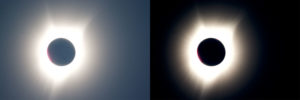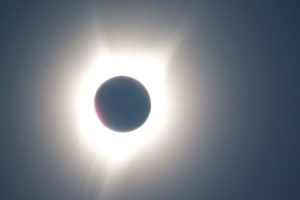The solar corona is a challenging photographic subject, particularly under the hurried conditions one encounters during the brief moments of totality, the only moments land-based astronomers will likely encounter the phenomenon. Modern cameras are very good at solving this problem, but even they aren’t perfect.
Below is a side-by-side of the same image, one “raw” from the camera and the other processed as best I know how in Photoshop–reducing the exposure, bringing the highlights into relief, etc. The “raw” image is the very first one I snapped once I determined that the eclipse had entered totality—the moon was safely blocking the sun and I could remove the solar filter from the lens.

Those images are a bit small, so here are the two separate images at “normal” size. (As usual with any image, you can click it for a larger version.)


As you can see, a little bit of processing in Photoshop really can bring out the details in a photo. I haven’t even cropped or done any of the normal things I would do to try to make an aesthetically pleasing, or at least interesting, photograph.
What I find most interesting about this image is how the camera overexposed it tremendously (the blown-out highlights of the corona are bleeding into the background sky, tinting it) but the corona is visible from top to bottom of the frame, and perhaps even beyond.
In my more “normal” exposed photos, where the camera’s sensors were able to leave the background sky dark in the “raw” images, the corona is nowhere near as extensive:

This is a case where auto-bracketing, which I’d meant to set up beforehand and forgot to do, would have been a lifesaver. In the one minute and forty seconds of totality, I couldn’t even see the dials on my camera, let alone figure out how to set up the bracketing.
You can bet I’ll do many rehearsals between now and April 8, 2024.







